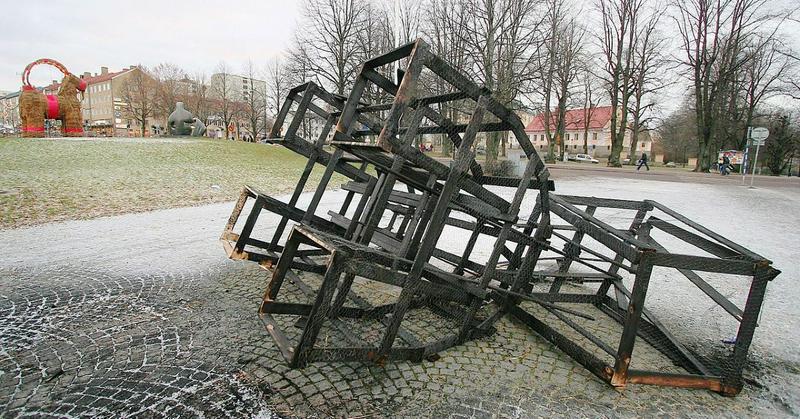Gavle Goat: The Swedish Traditional Display That Vandals Burn Down Every Year
By | December 18, 2020

Every year in Gävle, Sweden, the locals celebrate Christmas by erecting the Gävle Goat, a massive version of the Swedish yule goat. Made of wood and straw and decorated with lights and ribbon, the goat towers over the city square from the beginning of the advent until the end of the holiday season ... if it survives. Over the past 50 years, the Gävle Goat has been destroyed 35 times. Officials have done everything in their power to stop arsonists from burning the goat, but it looks as if nothing can stop their fiery Christmas tradition.
Christmas In Sweden
Christmas in Sweden in a multi-week celebration that begins on the first day of Advent, traditionally at the end of November, and lasts until St. Knut's Day on January 13. Modern festivities celebrate Sweden's pagan roots, including the yule goat, who has transformed over the years from a malevolent Christmas spirit who traveled from home to home demanding gifts to a kindly figure who checks in on families to make sure they've decorated properly for the season. Families decorate their trees with straw goats, and it's entirely possible that the arsonists behind the Gävle Goat's various demises see the act as a nod to pagan mythology as well, with its legends of animal sacrifice. It's just as likely that people just like setting stuff on fire, though.

The First Gävle Goat
In 1966, advertising consultant Stig Gavlén had the bright idea of placing a giant yule goat in the Gävle city square, hoping such a festive spectacle would drive tourism and boost sales at local shops. By December 2, 1966, the inaugural Gävle Goat stood just over 42 feet tall in the middle of the town square, but as the clock struck 12 on New Year's Eve, the goat was set on fire and burned to the ground.
The first arsonist to burn down the Gävle Goat was arrested and charged with vandalism, but that did nothing to deter future firebugs from picking up where the original vandal left off. In 1967 and '68, the goat survived the holiday, thanks in part to the addition of a protective fence, but in 1969, the goat went up in flames once again on December 31.

Giving Up The Goat
When the goat was destroyed a mere six hours after its construction in 1970, the group of businesses known as the Southern Merchants who had previously been responsible for financing the goat gave up on it, and the tradition was taken over by the Natural Science Club from the School of Vasa. Their version of the Gävle Goat was smaller and proved to be much easier to destroy: It's been burned, smashed, stolen, hit by a car, and destroyed before it even went up in the square.
In 1985, the N.C.S. found their ambition and built a 41-foot version of the goat that was featured in the Guinness Book of World Records. The group placed a six-foot fence around the goat, and it was supervised by members of an infantry regiment. (It survived all the way until January.) Today, the N.C.S. and the Southern Merchants, who have since rejoined the fray, build competing goats that are, alas, both often burned down. By 1988, gamblers had begun placing bets on whether the goat would burn and when it would happen.

Protecting The Goat
Gävle city officials have built fences around the goat, fireproofed it, and even set up webcams to monitor the goat with varying degrees success. In 2005, a pair of vandals dressed in Santa and gingerbread man costumes got around that whole fence thing by shooting flaming arrows at one of the goats. In 2009, after a vandal couldn't manage to set the N.C.S. goat on fire, they straight-up stole it. On December 23 of the same year, hackers took out the security cameras surrounding the Southern Merchants goat before having themselves a mountain barbecue. The only reliably effective deterrent is manpower: On years when volunteers are stationed at the goat throughout the night, the straw statues survive the holiday, but not for lack of trying. In 2010, a truly enterprising group offered a guard $50,000 to let them kidnap the goat via helicopter.
The annual construction of the goat has achieved its purpose by turning the eyes of the world toward this small Swedish town, but it's also invited vandals from all corners of the Earth to try their hand at destroying a huge Christmas ornament. In 2001, when a vandal from Ohio named Lawrence Jones was arrested for burning down the goat, the judge admitted that "the truth is that the goat is built to be burned," but it's meant to be enjoyed by the community. Jones was an outsider, and that, much like the Gävle Goat, simply will not stand.

